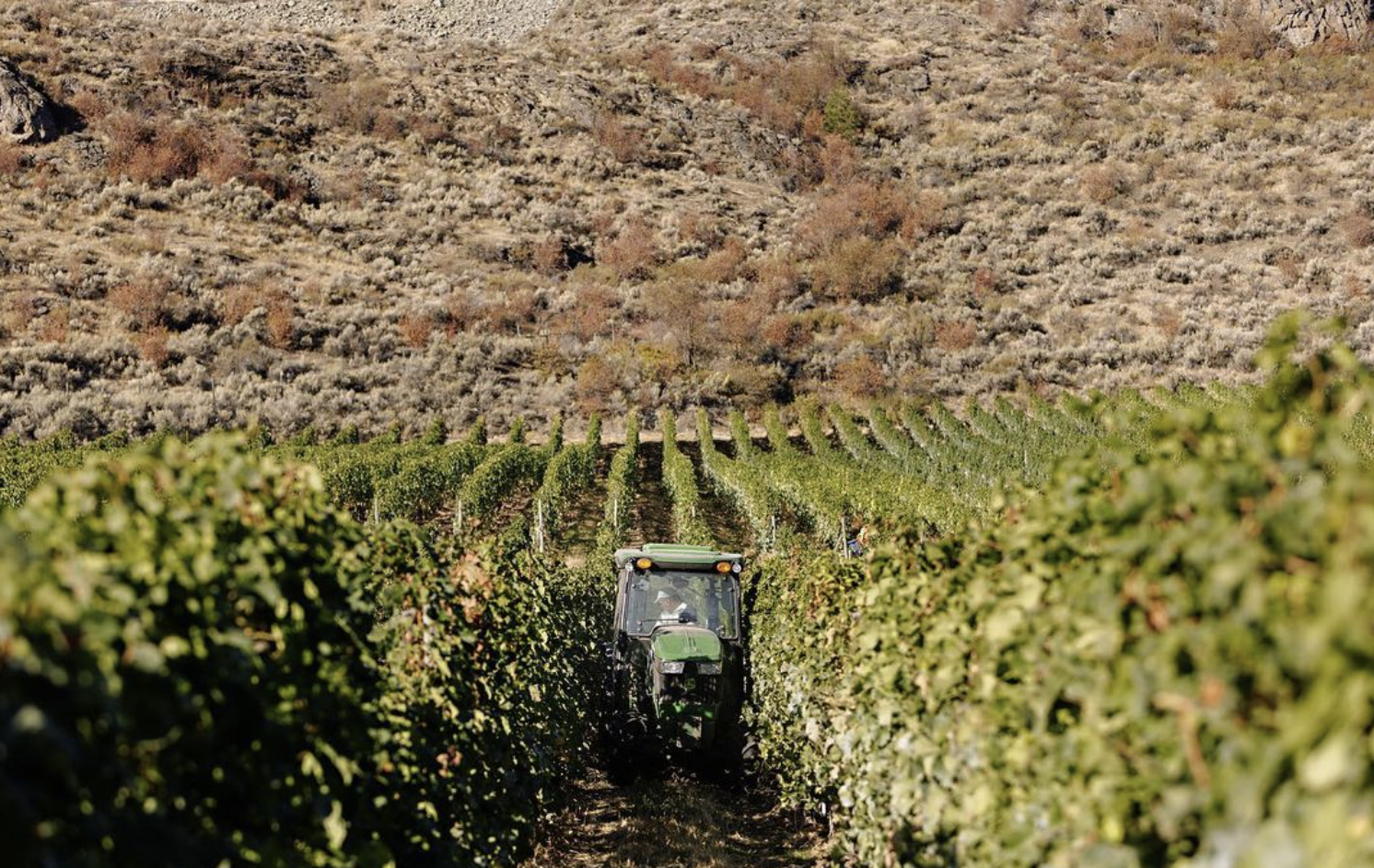
Last time when we wrote about wines from Canada, the diversity and quality of the cool climate wines from Ontario’s Niagara Peninsula came as a great revelation, as the winemakers there have been on a long and relentless path of expressing their unique identity. This time, we look to the West Coast around 2,000 miles away, where British Columbia quietly boasts some of the warmest (and dryest) growing conditions in Canada, with some parts getting more sunlight than Napa Valley at its peak!

Just like Ontario, British Columbia’s wine scene (dating back to the early 1900s) was originally focused on affordable bulk wines and largely unspectacular. But, as the industry faced major changes leading up to the Canada/USA Free Trade Agreement signed in 1988, there was a movement to establish grape varietal and wine quality standards to compete against better quality imports, just like Ontario. This led to the establishment of its own appellation of origin system, the British Columbia Vintners Quality Alliance (BC VQA) in 1990, which was largely modeled after the VQA established in Ontario in 1988.
Perhaps what gave the winemaking community in British Columbia confidence to establish the BC VQA was the successful Becker Project between 1977 and 1982. During this project, 33 vitis vinifera varietals imported by the federal government (over 4,000 vinifera vines were imported) proved to be able to ripen and produce premium quality wines in the Okanagan Valley, the largest wine region of British Columbia. Over time, thanks to some early pioneers that believed in the potential of British Columbia, the industry has grown from 19 licensed wineries in 1990 to today’s 300, covering over 11,000 acres of vineyards, the second largest in Canada; this is still relatively small scaled, and is comparable in size to the Finger Lakes wine region in NY which has around 11,000 acres of vineyards and around 150 wineries. Ontario is Canada’s largest region with over 17,000 acres of vineyards and around 190 wineries.
Today, a diverse range of red (e.g. Merlot, Pinot Noir, Cabernet Sauvignon, Cabernet Franc) and white (e.g. Pinot Gris, Chardonnay, Gewürztraminer, Riesling) varietals are available in British Columbia. This is possible since the region experiences extreme climate conditions. With freezing winters that can dip below -4°F, typical cooler climate and sensitive varietals such as Pinot Gris and Riesling can flourish here. But, the more surprising part is its short but extremely hot summers that can reach over 104°F, along with long sunlight exposure and wide diurnal temperature (temperature difference between night and day) swings. This allows sunlight and heat demanding varietals such as Merlot and Cabernet Sauvignon to properly ripen.
British Columbia has 9 different wine regions (officially called “GI” for Geographical Indication) that each have unique sets of growing conditions that can accommodate the needs of the varieties highlighted above. Take for instance the Okanagan Valley, the largest GI close to the US border having one of the hottest and driest growing seasons in Canada, is where Merlot and Cabernet Sauvignon are often planted to make full-bodied and elegantly structured wines. But at the same time, there is enough micro-climate diversity and influence from the Okanagan Lake so cooler varietals such as Pinot Noir and Pinot Gris are successfully planted.
There is also the small Vancouver Island GI located off the west coast of the Canadian mainland, with cooler conditions since it is right next to the Pacific Ocean. However, the mountains in the GI strips moisture away, creating dry enough conditions to plant delicate varietals such as Pinot Gris and Pinot Noir.
Another extreme example is the semi-desert conditions of Similkameen Valley. The GI lacks a large body of water to moderate the climate, resulting in extreme heat and cold conditions throughout the year. A wide range of varietals are successfully planted – Merlot, Chardonnay, Cabernet Franc, etc.
The full list of the 9 GIs are as follows:
- Okanagan Valley – largest GI, one of the hottest and driest region but influenced by a series of lakes.
- Similkameen Valley – second largest GI, similar climate as Okanagan Valley without large body of water.
- Vancouver Island – small GI off the west coast of mainland, generally cooler but dry conditions.
- Fraser Valley – small GI close to Vancouver, generally cool and receives abundant rainfall.
- Thompson Valley – a small GI that is semi-arid but moderated by the Thompson River.
- Shuswap – small GI north of Okanagan, the coolest region with high altitudes up to 1,000m.
- Gulf Islands – located next to Vancouver Island GI with similar conditions.
- Kootenays – easternmost GI that has challenging mountainous terrain containing many bodies of water.
- Lillooet – smallest GI with steep valley walls that runs along the Fraser River.
Given this diverse range of conditions, winemakers are developing more terroir driven interpretations of British Columbia wines. Even within the different GIs, there is a push to develop more sub-GIs to better establish distinct identities based on differing soil types, rainfall, growing temperatures, and other growing conditions.


While the wines from British Columbia are still hard to find in the US due to only small amounts exported, it is encouraging to see the region forging ahead to create their own identities of wine. From full-bodied ripe red wines to bright and mineral-driven white wines, winemakers seem to be pushing to realize the full potential of the region. Hopefully we get more opportunities to see their wines on this side of the border.
Below are the wines from British Columbia that were tasted as part of writing this article:
 Seaside Pearl, Charlotte Estate Petit Milo 2022, Fraser Valley
Seaside Pearl, Charlotte Estate Petit Milo 2022, Fraser Valley
Owned by husband and wife team David and Allisson Zimmerman, this is a small estate winery located on the central part of Fraser Valley along the Fraser River. Petit Milo is a hybrid variety unique to British Columbia; it is a cross between Cabernet Sauvignon, Riparia and Amurensis. This was a clean and rich white wine, with strong citrus and tropical notes along with a hint of honey.
Nk’Mip Cellars, Dreamcatcher 2022, Okanagan Valley
Pronounced In-ka-meep, it is the first Indigenous-owned and operated winery in North America. This is a bright and mouthwatering white wine that is a blend of Riesling, Ehrenfelser (a small German varietal), Sauvignon Blanc, Pinot Blanc, Chardonnay, and Semillon. With notes of citrus, stone fruit, and tropical fruit notes, the vibrant acid is balanced by the residual sugar, creating a rich mouthfeel without being sweet.
Spearhead Winery, Pinot Noir Saddle Black 2021, Okanagan Valley
A relatively young winery that was started in 2008 by Vancouver lawyer Bill Knutson and Marina Knutson, Spearhead focuses on Pinot Noir, along with some plantings of Chardonnay and Riesling. This is a concentrated and highly fragrant wine that has ripe red cherry and plum flavors, and some cinnamon notes towards the end.

Burrowing Owls Vineyard, Merlot 2021, Okanagan Valley
This family owned winery was started in the 1990s by real estate developer Jim Wyse, through a purchase of 100+ acres of abandoned vineyards while completing a development project; they own over 200 acres now. This is a full-bodied wine that has ripe and balanced black currant and cranberry/cherry notes with supple tannins, notes of herbs and spice in the background, and medium+ level acid that supports further aging.
Laughing Stock Vineyards, Portfolio 2020, Okanagan Valley
Established in 2003 by David and Cynthia Enns who left their successful financial careers to pursue a dream (hence called “Laughing Stock”), the winery focuses on growing and producing Bordeaux varietals. This wine is a blend of Merlot, Cabernet Sauvignon, Cabernet Franc, Malbec, and Petit Verdot. The ripe black plums and red fruits are balanced by the notes of cedar and leather, and along with structured tannins, there seems to be a long aging potential.
This is a follow up to the previous article on Niagara Peninsula’s cool wines.











